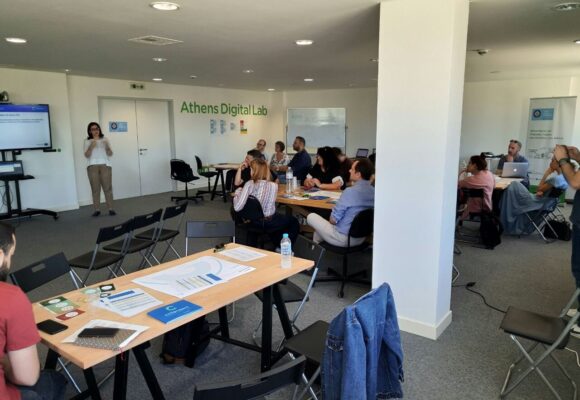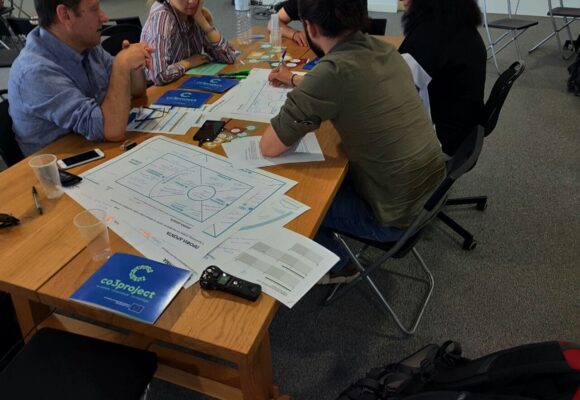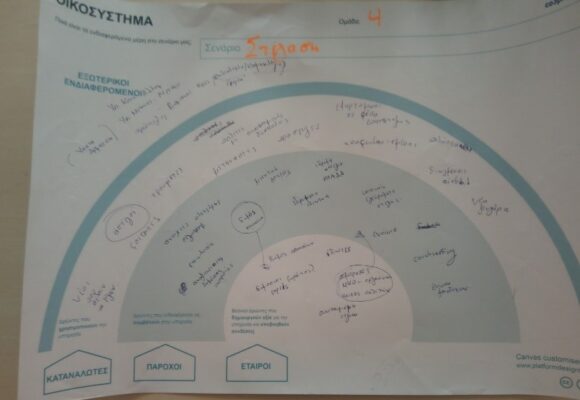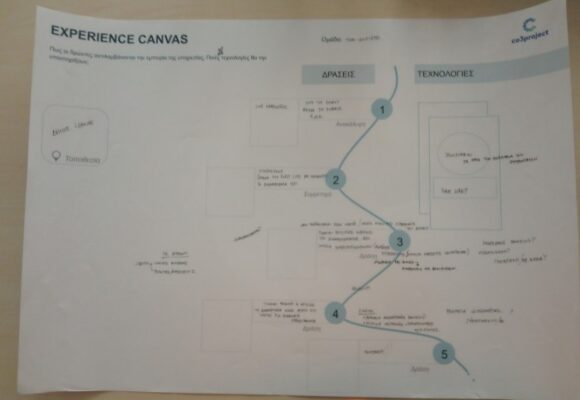The essential context of the Athens pilot scenarios and use-cases are social services and their improvement through the introduction of new technologies and the development of a common area where diverse beneficiaries and stakeholders can collaborate on the co-design and co-implementation the services. More specifically, social services to be involved in the testing of the Athens pilot were envisioned to include food provision and food-sharing to a vulnerable population. However, recent internal meetings with the Agency of Social Solidarity and Health of the City of Athens promoted the need to extend the use-case with sharing of other social goods such as housing, health and well-being services, skills, time-sharing, etc.
The food-sharing scenario of CO3 Athens pilot, social, and financial constraints impose a significant increase in the need for food provision. The existing services focus mainly on two categories of Athenians. On the one hand, unemployed, indigents, immigrants that usually face housing problems and use the service of meals provision. On the other hand, low-income families with children, elderly, and generally individuals with low income that has a house, but due to their financial limitations, they cannot buy essential goods such as sanitary products, clothing, food, etc. The agencies/offices of the City of Athens responsible for food-related activities is the Agency of Social Solidarity and Health, the City of Athens Homeless Shelter, operating under the supervision of the Agency.
The workshop was defined in different internal meetings of the Athens municipality and other project partners deciding to set a workshop program of 2 days of duration to achieve a high-quality result. The objectives of the workshop and the methodology that was followed required the participation of 4 different categories of attendees:
- City officials, public administrators, municipal employees under social services
- NGOs, organizations covering the field of social affairs (health, housing, food)
- Individual citizens, citizens’ groups and associations, consumers of social services
- Attendees with IT background, Informatics employees
These participants were recruited from different areas like:
- Public administration: Athens Mayor office and Deputy Mayor of Health and Social Solidarity, Chief Digital Officer for Digital Transformation of Athens
- Social agencies of health and solidarity: Friendship Clubs Dpt., Support and Immigrants/Refugees Social Integration Dpt., KYADA, Open Schools, Impact Hub Athens, SynAthina, Athens Digital Lab, ESTIA program, Social food-sharing of Equal Society Organization, Solidarity initiatives “Mirmigki” and “Allos Anthropos”.
- Churches: Orthodox Church of Greece
- NGOs: “MISSION” established by the Orthodox Church, Aggelikousi Institute, “Steps”, “Solidarity for all”
- Companies (Public Gas Corporation of Greece DEPA, COSMOTE telecommunication company)
Workshop preparatory phase
Before the workshop, OLA conducted two internal training sessions, one in the premises of DAEM and one in a local technology partner, Sociality Coop. with an extensive presentation of the CO3 technologies followed by a discussion of their pros and cons and how these technologies could better be communicated to the other participants of the co-design process.
OLA and DAEM also worked on the contextualization and localization of the CO3 toolkit material, personalizing the canvases to the Athens use cases. Two pilot workshops rehearsals before the actual one were organized to have a better idea of the process and spot the difficulties. Based on this experience, the following modifications were implemented for this case:
- The Actor Canvas was altered to include the potential role of the technologies in surpassing barriers to achieving the expected outcomes
- The Value Proposition Canvas was altered to a simpler version which focused on the expected outcome in order to solidify consistency among canvases
- The cardeck provided was altered to only include the Technologies and a small description of them in order to avoid non-essential information that could distract the participants
- The technology presentation was simplified and focused more on use cases and not on how the technology works
- We added technology badges that could be used on the canvases to indicate the potential use of the technology on the services discussed
- We decided to provide hands-on experience of the technology in the workshop venues with laptops displaying prototypes of the available consortium technology applications.
Workshop session
The workshop was conducted in two sessions, the first one to complete the Stakeholder Mapping, the Value Proposition Canvas, and a plenary non-voting session regarding it, while the second session was dedicated to the Experience Canvas in more design-oriented and experienced groups. The aim was to have the participants of the second workshop that also participated in the first.
Each table discussion was recorded alongside the filled canvases and a report generated to each table coordinator (facilitator). This provides richer information for the posterior analysis of the results. Each table was composed of 5 participants, a facilitator, a technology expert, a public administrator executive, a social worker (NGO), and a citizen (beneficiaries). The topics covered were food, health, and housing distributed along five tables.
Initially, an informational slot was dedicated to the introduction of the participants to the co-design process and its objectives for the CO3 project that aims to actual pilot implement these proposals to assert the impact of the technologies and the co-production concept itself. Thanks to those technology experts already are informed on the CO3 technologies, they have played a vital role in bringing the technology perspective into the discussion.

The PA executives were able to provide essential information on how this kind of services already operate and also stretch their potential and challenges. Members of social initiatives brought in a more social perspective and expressed the possibilities which emerge when citizens have an active role in providing these essentials, especially in times of austerity when public social services have limited capacity. Citizens brought in a more personal approach to expressing their needs and aspirations.
Stakeholder mapping
Table 1 and 2 with food as the topic, generated a similar stakeholder mapping, they identified as consumers the homeless, indigents, migrants, elderly, children, etc. And as providers’ food-banks, private solidarity entities, street workers, supermarkets, church, etc. The partners were associated with the municipality, social partners, logistic companies, cooks, etc.
Table 3 with health topic, have identified as consumers the people with disabilities, homeless, children, older adults, etc. and as providers the group of citizens, NGOs, social pharmacy, municipal health centers, etc. As partners, the church, municipality of Athens, greek state, etc.

Tables 4 and 5 with the housing topic identified as a consumer, the youth people, students, homeless, immigrants, etc. And as a providers housing platforms, municipality abandoned buildings, KYADA, hotel associations, citizens renting a room or house. As partners, the municipality of Athens, NGOs, private entities, housing coops, etc.

Value Proposition canvas
Tables 1 and 2 with food topic, proposed as value the stable and constant access to quantitative and qualitative food to increase the quality of life and improve social stability and cohesion. This is achieved with the usage of geolocated technologies as the CO3 FirstLife platform for mapping the points of product distribution and the small producers are located. LiquidFeedback was selected to provide an evaluation and decision over the services and the blockchain to track the food delivery quantity and control who is receiving and how much food is being delivered. This will simplify the reporting process in the case that is founded by a third party/administration. Some of the participants suggested the delivery of QR code to enable the final user to obtain the goods and maintain the tracking.
Table 3, with health issues, proposed as value to improve the utilization of medicines that are no longer needed by some people by publishing over the FirstLife geolocated platform. To limit and avoid the abuse, Blockchain is suggested as an identity method since it can store personal medical data ensuring privacy because of its possible anonymity. FirstLife will help with the visualization of the supply and demand for health services.
Tables 4 and 5 that covers housing topic, proposed as value a public service similar to the Airbnb but based on social collaboration, linking people who own empty/abandoned houses with people that need them. It also provides an interface to the people that wants to share buildings facilitated by third entities as social housing. FirstLife map can show buildings moderated by the municipality (previously filtered), and the building is added with indications about the owner exigencies (given by repairs, money contribution, etc.). If the municipality wants to reward the owners, it can be provided in the form of tokens supported by a blockchain. This platform, as a difference to Airbnb, doesn’t have the objective of win money by taxes.
Experience canvas
For this second phase, the food and health topic tables were combined in a single one to define de experience canvas. In the case of health, it was found that the discovery step is not as easy because the user’s limitation about its knowledge of the technologies, this can be overcome by the help of caretakers. Still, it might appear a privacy problem in the case of the FirstLife platform. Participants proposed the use of a proxy using a phone. In the case of the food, the discovery is possible by the KYADA and citizens’ help center. The beneficiary can engage using a mobile application or a terminal installed on different facilities. The users can also use the QR codes to get the necessary food. But the experience canvas is filled from the perspective of the facilitator as its possibility of technology access.
In the case of the tables about housing, the points with the main concern are the transparency, motives, protection of the property, the owner rights, and the trust between homeowner and beneficiary. This requires the engagement of the municipality as a legal representative to protect all previous points. The service discovery can be reached by field trips, conventional campaigns, social media, and city excursions defined by the architectural school to identify different locations with potential uses and start a discussion on platforms like LiquidFeedback to vote and decide. Although, the group described that physical participation is essential on the visits to ensure active interest.

Conclusions
There are some privacy, inclusion issues that should be taking in care to the CO3 technologies implementations. Some participants were reluctant to use augmented reality or blockchain technology, being in some cases stripped most of their features to be accepted by these participants. In another example, the FirstLife was reduced to a simple 2D map instead of a geolocated social media map. This co-design process revealed that cultural, social, technical issues like the found would emerge during the implementation phase, and the group in charge of the implementation should be ready to overcome all of these issues.


